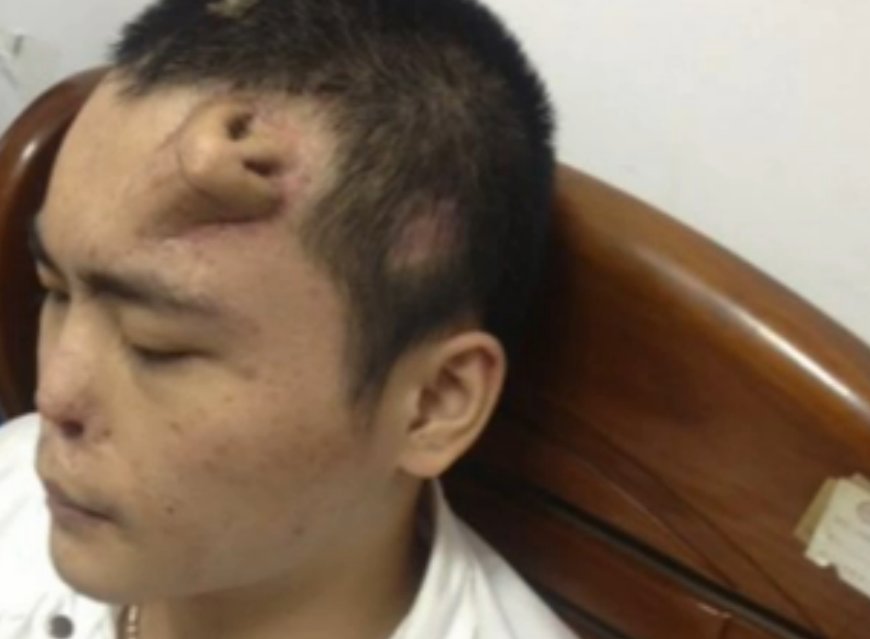
Editor's Note: This story was updated on Sept. 26 at 9:55 a.m. ET.
Despite his perhaps bizarre appearance, a man in China who is growing a new nose on his forehead is the beneficiary of a rather common nose reconstruction technique.
The man suffered damage to his nose and an infection after a severe car accident, and the infection had eaten away at the cartilage in his nose, making it impossible to for doctors to fix his original nose. Instead, the team decided to grow the man an entirely new nose on his forehead, according to the Huffington Post.
But despite its extreme appearance, this method is really just a variation of plastic surgery techniques used all the time, said Dr. David Cangello, an attending plastic surgeon at Lenox Hill Hospital and Manhattan, Eye Ear and Throat Hospital in New York.
"I would call it a different take on a principles that we commonly use in reconstruction," Cangello said.
Forehead nose
The man's doctors placed tissue expanders, which create space to stretch the skin, under the man's forehead, and created the rough shape of a nose. They then harvested cartilage from his ribs to create a frame for the nose, probably using screws and plates. Once the nose is ready, they will rotate the entire assemblage — skin, blood vessels, cartilage and all — and move the new nose to where his current nose sits.
Sign up for the Live Science daily newsletter now
Get the world’s most fascinating discoveries delivered straight to your inbox.
That is only slightly different from current methods of nose reconstruction, Cangello told LiveScience. Though reconstructive surgeons would also put tissue expanders under the forehead skin to stretch the skin enough to cover the new nose, they would place the nose differently.
"We typically take the cartilage from the rib, and we put it right where the nose structure would already be, and we bring the skin flap over it and cover it," Cangello said.
Afterward, the doctors suture together the skin flaps of the forehead or leave the skin to heal on its own, which will usually leave a small scar. [10 Technologies That Will Transform Your Life]
Key blood vessels
Though it may seem like a patient might prefer to grow a new nose on a different part of the body that could be more inconspicuous, there are good reasons to use forehead skin.
"Skin that comes from another area of the face will most resemble the skin of the nose, as opposed to skin that came from another body part," Cangello said.
The forehead also has blood vessels that nourish the tissue transplant, so the surgeons don't have to disconnect and reconnect those vessels to place the nose in its correct position. If the doctors were to grow the nose on a forearm or a leg, for instance, they would have to undertake a laborious microsurgery to take the blood vessels that feed and drain the transplant.
Better nose?
The man still seems to have a nose that, at least in pictures, looks fairly normal. By contrast, his replacement nose is pretty large.
But the new nose should contract to some extent once it's in place, he added.
It's also possible the researchers needed to replace the man's current nose because he had trouble breathing properly.
"Whenever we perform a reconstruction, there are two things in mind," Cangello said. "It's not just form, but it's also function."
Editor's Note: This story has been updated to add more detail and to clarify the techniques used for nose reconstruction.
Follow Tia Ghose on Twitter and Google+. Follow LiveScience @livescience, Facebook & Google+. Original article on LiveScience.

Tia is the managing editor and was previously a senior writer for Live Science. Her work has appeared in Scientific American, Wired.com and other outlets. She holds a master's degree in bioengineering from the University of Washington, a graduate certificate in science writing from UC Santa Cruz and a bachelor's degree in mechanical engineering from the University of Texas at Austin. Tia was part of a team at the Milwaukee Journal Sentinel that published the Empty Cradles series on preterm births, which won multiple awards, including the 2012 Casey Medal for Meritorious Journalism.










